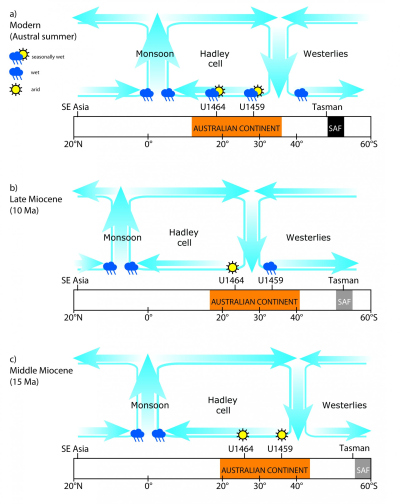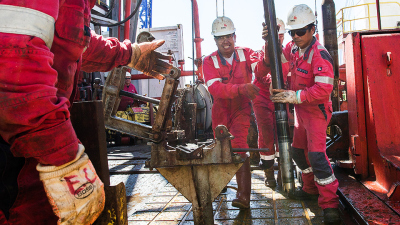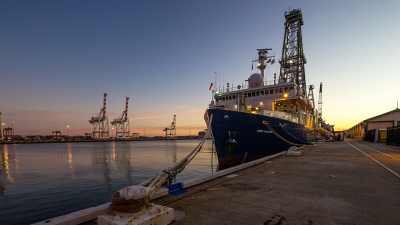- Home
- Our Offers
- Media
- Archive Media Releases
- Media Releases 2017
- Westerlies
Climate change shifts westerlies
"Using downhole wireline logging data has the enormous advantage that you get a complete and thus continuous sediment record which has not been influenced by potential drilling disturbances," says first author of the study Dr. Jeroen Groeneveld from MARUM - Center for Marine Environmental Sciences at the University of Bremen.
Changeable in the north, rainy in the south
Today's climate in western Australia changes from north to south; in the north the seasonal monsoon brings pronounced dry and wet seasons, further south climate is dry throughout the year, and in the south the westerly winds bring rain during austral winter. The expedition aimed to find out how this climate gradient developed over longer time periods, especially the Miocene and also the Pliocene.
On these longer timescales tectonic changes play an important role because the northward movement of Australia away from Antarctica and the gradual closing of the Indonesian Gateway affect how warm waters from the Pacific enter the Indian Ocean. Global climate during the Miocene was much warmer than today, with a lower temperature gradient between the equator and high latitudes. At the end of the middle Miocene (around 14 million years ago) a large part of Antarctica became glaciated and continued to cool the Southern Ocean into the late Miocene.
Groeneveld and his co-authors used natural gamma-ray data acquired with downhole logging during the expedition to reconstruct variations in river runoff and dust and relate these to a history of precipitation and aridity for western Australia. The natural gamma-ray data were expressed by the concentrations of potassium and thorium and their ratios. Potassium is mainly transported to the site locations as river-derived sediments. Thorium is more dominant in dust-transported grains, so that the ratio of thorium over potassium shows relative changes in how wet or dry the hinterland was.
Impact on climate in Southeast Asia
Northwest Australia was mostly dry during the Miocene also evidenced by the mineral anhydrite that only forms when large amounts of seawater evaporate, but the southwest showed a dramatic increase in precipitation from 12 to 8 million years ago. This period parallels cooling of sea water temperatures throughout the Southern Ocean and possibly even expansion of sea ice around Antarctica. This cooling caused the band of westerly winds around Antarctica to be pushed northward and made south Australia very wet, while the north stayed dry. The consequence of a northward migration of the westerly winds was that the main atmospheric weather systems were also pushed northwards resulting in major precipitations shifts in the tropics.
"Our research shows that climate change around Antarctica can severely impact the amount of precipitation falling in Australia and even has impacts on how precipitation and aridity are distributed all over southeast Asia," says Groeneveld.
More information:
Dr. Jeroen Groeneveld
Telefon:0421-21865455
E-Mail: [Bitte aktivieren Sie Javascript]
Jeroen Groeneveld, Jorijntje Henderiks, Willem Renema, Cecilia M. McHugh, David De Vleeschouwer, Beth A. Christensen, Craig S. Fulthorpe, Lars Reuning, Stephen J. Gallagher, Kara Bogus, Gerald Auer, Takeshige Ishiwa, Expedition 356 Scientists: Australian shelf sediments reveal shifts in Miocene Southern Hemisphere westerlies. Sci. Adv. 3, e1602567, DOI: 10.1126/sciadv.1602567, 2017





